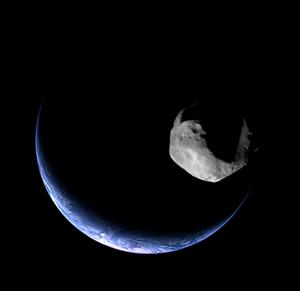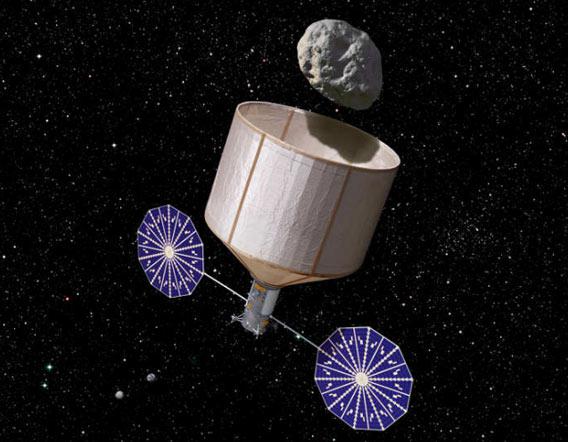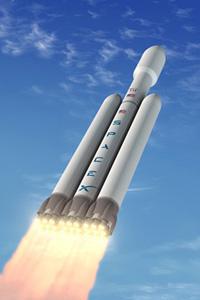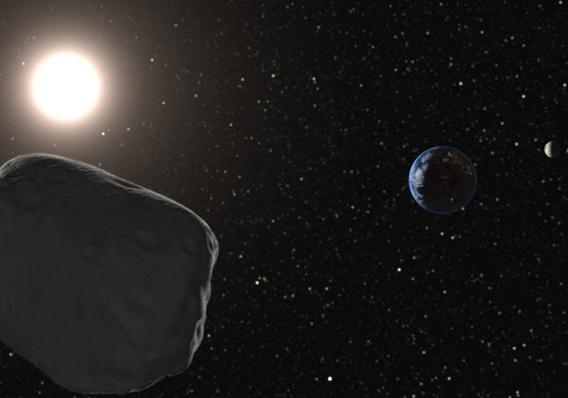By now, you may have heard the news: NASA will get $100 million in the White House budget to start looking into a mission to tow a small asteroid near the Earth, with the eventual plan to send people up to study it. There are a lot of sites talking about this, and it does look like the basics of this story are true.
My first reaction to that was “Holy wow, that is so cool!”
After a moment, though, my second reaction was a lot more skeptical. Mind you, we don’t have a lot of details yet. What info we do have is mostly from comments made by Senator Bill Nelson (D-FL) at a press conference. We won’t have solid facts until the NASA budget is announced sometime this coming week (probably Wednesday).
But even then, I have some concerns about this. Mind, you I love the idea! I’m just not exactly sure how they plan to actually do it. You can’t just build a rocket, go to an asteroid, throw a rope around it, and bring it back.
Let me give you an overview of the idea as we know it, and then I can explain why I have reservations. I’ll note that all my doubts can be overcome, but I’ll need some very solid details before I make up my mind about this.
The Plan
Much of what I will write about here is based on my own knowledge of asteroids, as well as on a study done in 2012 by the Keck Institute for Space Studies (what I’ll call the KISS report) to investigate the feasibility of an asteroid rendezvous and return mission. The report is fascinating, if a bit technical, and I highly recommend reading it. I’ll note that the total cost of the mission is estimated by the KISS report at $2.6 billion, and that’s just for getting the asteroid here. That does not include sending people up to investigate it.
The idea here is to be able to study a small asteroid up close. This is important for a lot of reasons. For one, these things sometimes hit us, in case you’ve forgotten. The more we know about them, the better. And while we know quite a bit about asteroids, there’s a lot we don’t. Some are metallic, some stony, some literally loose collections of rubble held together by their own gravity. Each of these behaves differently, so getting a nice, long look at one up close is a good idea. Also, asteroids are pretty interesting scientifically, and well worth our attention.
Overall, the steps for this mission would be 1) find a good asteroid target, 2) send an uncrewed probe to it, 3) capture it in some way, 4) tow it back home, and 5) study it.
Sounds easy, right? Yeah, not so much. I’ll be clear: According to the KISS report, it’s feasible. But it’ll take a lot of work, it’ll be hard, and it’ll have to be done according to plan. I’ll get back to that last part at the end.
Step 1: Find ‘em
An asteroid small enough to move around can’t be more than about 5-7 meters across—roughly the size of a nice living room (with a high vaulted ceiling). At that size, and made of rock, it would have a mass of a few hundred tons, give or take. Volume (and therefore mass) increases with the cube of the diameter, so a rock 10 meters across would have eight times the mass of one five meters in size! So the upper size limit is a pretty firm one.

Image credits: Earth: ESA/Rosetta; asteroid Mathilde: NASA/NEAR
But a rock that small is faint. We’ve been scanning the skies for years, but only a handful of asteroids that size have been found (while the list at that link is not complete, it shows only a few dozen asteroids even close to the right size have been found). Even then, we’re not really sure about their size; only an estimate can be made given current techniques. Knowing the size beforehand is absolutely critical to this mission: You can’t think the rock is five meters across, then get there and find out it’s actually 10! As I describe in the next section, if it’s too big then you can’t bring it home, and your mission fails.
So first things first, we need to find these things. And not just any five-meter asteroid will do. It has to be on a pretty specific orbit; if it approaches too quickly then you’d have to carry too much fuel to put it into orbit. It also has to approach the Earth at the right time, so we don’t have to delay a launch for ten years, or have it take too long to tow it back. Heck, even just finding them isn’t enough; we have to be able to observe them long enough to get a good orbit determination. All of these cull the list of potential objects pretty savagely.
Rocks that size are incredibly difficult to find from the ground; the ones we have so far were found only when they were very close to Earth. According to the KISS study, ground-based observatories might be able to find about 5 such targets per year that can make that cut. That’s not bad, but I suspect realistically we’ll need a much larger sample to choose from given all those caveats above.
A better method is to have a dedicated space-based mission that looks in the infrared (where, due to the physics of the way asteroid sizes are measured, the sizes of the rocks are far more accurately found). [UPDATE (Apr. 7, 2013, 17:15 UTC): Coincidentally, I found a great description of this on Google+ just hours after posting this article.] There are two missions currently in the works to do just this: Sentinel and NEOCam. Both are excellent, but at best neither will be ready for launch for some time; Sentinel has a target date of 2018, and NEOCam would be a couple of years later.
Both missions should immediately yield a pretty nice list of small asteroids on the right orbits for this mission. But that’s only the first step.
Steps 2-4: Snag It, Tag It, and Bag It
These steps aren’t exactly a walk in the park either. The technology to build a space probe like this exists, more or less. But we’ve never actually done this before, and problems are legion. Most small asteroids in this size range are rapid rotators: they spin quickly. You can’t just float up and grab one! You have to de-spin it. Making things more fun, most of them tumble, flipping around rather chaotically.

Image credit: Rick Sternbach/KISS
This doesn’t make things impossible, just really hard. One idea (which I love) is literally a big can-shaped bag on one end of a probe. The probe then approaches the rock, matches the motion and spin rate of the rock as best it can, then approaches it until the rock is in the can. What are essentially draw strings then pull the bag closed. The asteroid will bump and grind a bit in there but the spacecraft can compensate for that using thrusters until everyone comes to a rest.
At this point, the probe with its prize will come home. But what’s “home”? Putting it into a low-Earth orbit is out of the question; besides needing way too much fuel to be feasible, it’s not a great idea politically to tell people we’re bringing an asteroid into an orbit 500 kilometers above their heads, no matter how carefully you phrase it!
Two other options would be in orbit around the Moon, or in a special orbit about 1.5 million kilometers (930,000 miles) from the Earth called the Sun-Earth-L2 point. Either of these is doable given the mission requirements, though again it’s not exactly simple. It will also take several years to nudge it back to Earth.

Image credit: SpaceX
Step 5: Poke it with a stick
Once safely in orbit around the Moon or at the L2 point, we need to get people there to take a look. That was outside the scope of the KISS study, but essentially it means a crewed mission. It’ll take a few days or weeks to get the astronauts where they’re going, then they’ll need time to study the asteroid, and then they’ll need to come back (with samples!). That means supplies for several weeks, equipment to study the asteroid, and so on.
And that means big bucks, on top of the $2.6 billion already spent just to bring the asteroid here. The idea is to get the rock in place around 2025, and by then we should have several options for launching people into space; for example SpaceX should have the Falcon Heavy going well before then. NASA has its own plans for a launch system as well (though I’m more skeptical of that at this point; SpaceX has a pretty good track record so far). Other companies are working on this, too.
Reservation, please
A concern, of course, is that none of it has ever been done before. We can build probes and send them to asteroids (we’ve done that several times), but the type of rendezvous, the capture, the towing…those are new. Mind you as well, right now no nation or company has the capability to send humans to the Moon or to the L2 point, either. Hopefully in ten years (or sooner) we will, but it’s worth pointing out where we stand at this exact time.
This is a fantastically complex detail-oriented mission, with lots of steps along the way, many of which depend on technologies and missions we don’t yet have. Given the price tag—realistically, substantially more than $2.6 billion—this is an Apollo-scale idea. That’s fine by me, and an apt analogy: we hadn’t done any of the steps needed to get to the Moon before Apollo either. I’d love to see NASA taking on big ideas again!
But—and this is my biggest, my true concern—this has to be done right. That doesn’t always happen. Without a clear plan, and I mean a really clear plan, I get nervous. I love NASA, but historically when they start up a project without a clear plan, a lot of time and money can get wasted.
So I worry. We need to do a lot of work before we can even begin to build the space probe, including some way of finding lots of target asteroids. The promised $100 million is a nice start, but realistically it’s only a couple of percent of what’s needed to get this done.
And, of course, NASA is funded by the government, which would charitably be called dysfunctional right now. Congress is currently so contrary and so tight with money I’d have a hard time believing they’d fund a stick of gum for the White House.
So for now I’m taking this asteroid mission news with a five-meter diameter grain of salt. We’ll have more info in a few days, and hopefully it will include a sensible plan for undertaking a mission of this scale. If there is, I’ll happily and enthusiastically cheer it on. If not, well, you’ll be hearing more from me about it.
